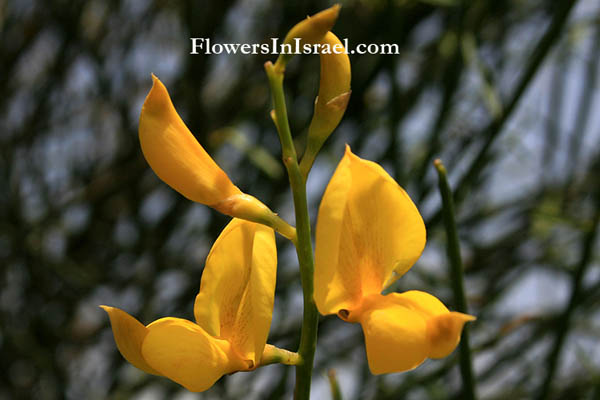Hebrew: אחירותם החורש, Arabic: وزال
| Scientific name: | Spartium junceum L. | |
| Synonym name: | Genista juncea (L.)Scop. | |
| Common name: | Spanish Broom, Weaver's broom, Rush Broom | |
| Hebrew name: | אחירותם החורש | |
| Arabic name: | وزال | |
| Family: | Papilionaceae, פרפרניים |

|
| Life form: | Phanerophyte, shrub | |
| Leaves: | Alternate, entire | |
| Flowers: | Yellow | |
| Flowering Period: | April, May, June | |
| Habitat: | Mediterranean maquis and forest | |
| Distribution: | Mediterranean Woodlands and Shrublands, Montane vegetation of Mt. Hermon | |
| Chorotype: | Mediterranean | |
| Summer shedding: | Perennating |

Derivation of the botanical name: Spartium, weavers' broom, a kind of grass used for weaving and cordage, not this shrub. junceum, rush like. Genista, a Latin name from which the Plantagenet kings and queens of England took their name, planta genesta or plante genest, and alluding to a story that when William the Conqueror set sail for England, he plucked a plant where it was holding fast, tenaciously, to a rock and stuck it in his helmet as a symbol that he would also hold fast in his risky endeavor. The plant was the common broom flower, called planta genista in Latin. This is a good story but unfortunately William the Conqueror came well before the Plantagenets and it was actually Geoffrey of Anjou who was nicknamed the Plantagenet because he carried a yellow-flowered sprig of broom on his helmet as a badge (genêt is the French name of the broom shrub), and it was his son, Henry II, who became the first Plantagenet king. Other historical explanations are that Geoffrey planted this shrub as a hunting cover or that he used the broom to scourge himself. It was not until Richard, Duke of York, father of both kings Edward IV and Richard III, that members of this family adopted the name Plantagenet, and it was then retroactively applied to the descendents of Geoffrey of Anjou as the dynastic name. The Hebrew name: אחירתם, achirotem, (Lit.: ‘brother of the broom', from אחי, achi, construct state of אח ־, ach(=brother), and רתם, rotem (= broom).
|